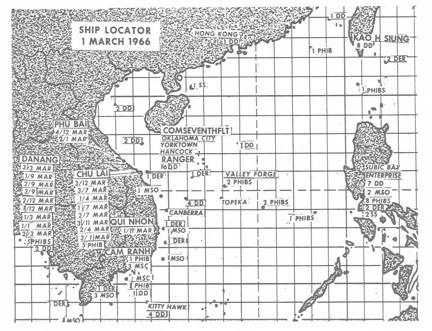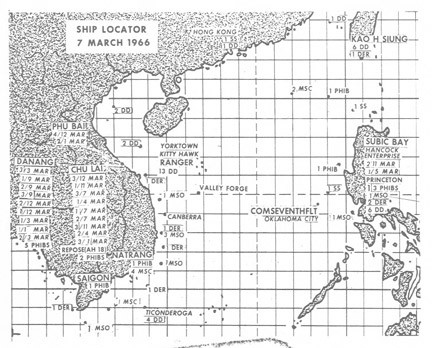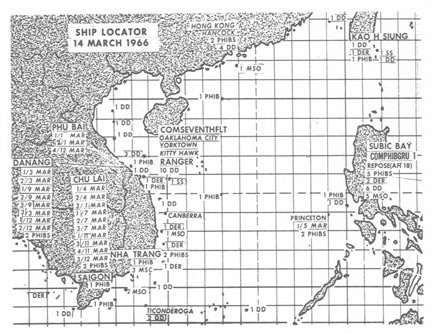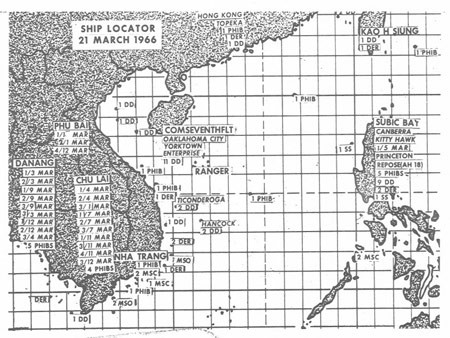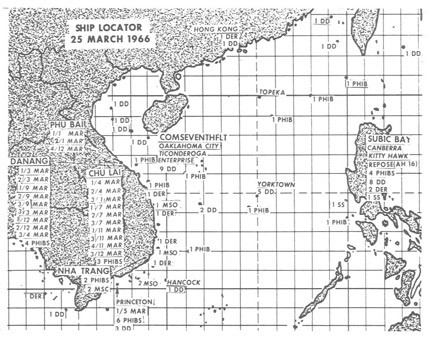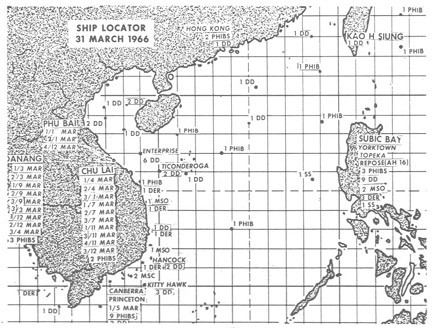Highlights March 1966
Highlights and Introduction
During the month of March, almost 100,000 naval officers and men were assigned to the Seventh Fleet and to supporting shore activities. A large percentage of the forces afloat operated in the Southeast Asian area. Seventh Fleet ships normally deployed off South Vietnam itself included:
- CVA - 3
- CVS - 1
- Cruiser - 1
- DD types - 31
- Submarines - 3
- Amphibians - 30
- Minecraft - 8
- Fire Support ships - 4
During the month TF 77 flew 3379 combat sorties in South Vietnam, 1915 over North Vietnam, and 1260 in Laos. Further, 19,300 rounds of 5, 6, and 8 inch ammunition were fired at the enemy. Finally, a major amphibious landing (Operation JACKSTAY) was launched against a Communist stronghold in the Rung Sat Special Zone in South Vietnam.
Aside from this major force afloat, 12,000 officers and men of the Navy were ashore in South Vietnam. Major organizations included:
- Naval Support Activity, Danang (3599) which provided logistic support to the Third Marine Amphibious Force and other American units in the northern portion of the country.
- 30th Naval Construction Regiment (3155 men) which also supported the Third Marine Amphibious Force in the Danang and Chu Lai areas.
- Medical, dental, and chaplain personnel (2188 men) assigned directly to the Third MAF.
- Naval Advisory Group, Military Assistance Command Vietnam (982 men). This command, located at Saigon, had operational control over the United States coastal patrol and continued to influence the Vietnamese Navy's readiness and will to fight.
- Headquarters Support Activity, Saigon (952 men).
This command, scheduled to be phased out by June 1966, gave logistic support to American forces in the Saigon area and many other parts of the country.
Arrayed against this imposing naval strength, and against the more than 515,000 men from South Vietnamese and other American services, were the Viet Cong and their allies from the North who had a total strength of almost a quarter of a million regular, irregular, and administrative forces. During the month of March, the Communists launched 52 organized attacks in addition to 2332 acts of terrorism aimed at cowing the civilian population into submission. The Communists had some degree of control or influence over about 25% of the population and 50% of the country side.
A final basic aspect of the overall picture in South Vietnam was growing evidence of renewed internal dissension aimed at the Saigon Government of General Nguyen Cao Ky. This unrest was triggered by the decision on 10 March to remove General Ky's major rival in the country, General Nguyen Chanh Thi, the Vietnamese commander of I Corps. In the aftermath of this step, demonstrations, centering in Danang and Hue, were led by Buddhist elements. By the end of the month, General Ky was threatening the use of armed force unless order was restored. Although these disturbances did not materially affect the American military effort, they represented a threat to the domestic stability of the Republic of South Vietnam upon which permanent pacification of the country depended to large extent.
Following approval of the Joint Chiefs of Staff in February 1966 of the establishment of a U. S. Naval Component Commander for Vietnam, the Commander in Chief Pacific Fleet laid plans during March for the new organization. To be known as Commander, U.S. Naval Forces, Vietnam, this organization was scheduled for activation on 1 April 1966. The Commander's billet was to be filled by Rear Admiral Norvell G. Ward, USN, who had formerly been Chief of the Naval Advisory Group, Military Assistance Command, Vietnam.
The primary purpose of COMNAVFORV is to bring under single command virtually all of the 12,000 men ashore in South Vietnam or operating in coastal and inland waters. Under Admiral Ward will be the Naval Advisory Group, the Naval Support Activities in Saigon and Danang, the 30th Naval Construction Regiment, CTF 115 (coastal patrol force), and CTF 116 (river patrol force). Operational control over COMNAVFORV will be exercised by General William C. Westmoreland, USA, Commander United States Military Assistance Command, Vietnam. Administratively, Admiral Ward will be under Commander in Chief Pacific Fleet.
The Navy's far-ranging carrier aircraft flew more than 6500 sorties over South Vietnam, North Vietnam, and Laos. 3379, or a daily average of 112, were flown in South Vietnam; 1915 in North Vietnam; and 1260 in Laos. During these operations, 11 naval planes were lost. Nine pilots and one crewman were lost or missing.
Primary targets in North Vietnam and Laos were infiltration and supply routes used to support the Communists in the South. Within South Vietnam itself, close air support and armed reconnaissance flights predominated.
As before, the Navy's carriers operated continuously at Yankee Station in the Tonkin Gulf and at Dixie Station off the central coast of South Vietnam.
On the first day of March, a RANGER F-4B failed to return from a bombing run. Extensive SAR efforts conducted in the area 13 miles east of Thanh Hoa produced negative results. On the same day, a RANGER A-4E became separated from his wingman in a low visibility turn and failed to return to the ship. SAR search centered around a position 12 miles northwest of Cap Mui Ron, but with unsuccessful results.
During the week of 2 to 8 March, combat operations were conducted by HANCOCK (TG 77.3), TICONDEROGA (TG 77.5), KITTY HAWK (TG 77.6), and RANGER (TG 77.4). Results of strikes in North Vietnam were good during several days of improved weather. SAM activity increased with an apparent firing as far south as Ha Tinh. Three SAM's were fired at RANGER aircraft on 4 March, but without damage. KITTY HAWK conducted in-country support operations from Dixie Station through 5 March with the airwing flying an average of 100 sorties a day. TICONDEROGA relieved her on 6 March, and KITTY HAWK in turn relieved HANCOCK at Yankee Station. On 5 March a HANCOCK A-IH crashed when it received a direct hit from AA fire while on a bombing run in North Vietnam. There was no possibility of survival. On the same day a KITTY HAWK F-4B was lost during in-country operations, presumably to ground fire. The crew ejected, and both pilot and RIO were safely recovered by helo.
During the week of 9 to 15 March, the carriers at Yankee Station were RANGER and KITTY HAWK. Winter monsoons continued to restrict air operations in North Vietnam, and a large number of scheduled sorties were diverted to operations in the South. On 10 March KITTY HAWK provided close air support for the beleaguered special forces at Ashau. The performance of the airwing in carrying out this mission earned the personal praise of General Westmoreland.
On 14 March the two-man crew of an Air Force F-4C ejected into the Gulf of Tonkin, west of Hon Me Island. A USAF HU-16 rescue aircraft attempted the recovery of survivors but was shot down and sunk by enemy mortar fire, leaving six more men in the water for rescue. KITTY HAWK aircraft attacked the shore batteries and small craft attempting to reach the men in the water. KITTY HAWK reported four sampans sunk and over 60 North Vietnam troops killed. Two YORKTOWN SH-3 helos, under cover of RANGER A-IH aircraft, moved in for the pickup despite heavy fire and rescued five of the eight men in the water. Heavy fire and damage to one SH-3 helo forced both helos to leave the scene. Under heavy fire, however, an ENGLAND (DLG 22) UH-2 helo proceeded into the same area and rescued another survivor. BERKELEY (DDG 15) and ARNOLD J. ISBELL (DD 869) arrived from SAR stations and, receiving heavy fire from shore batteries, returned it in kind. They remained in the area
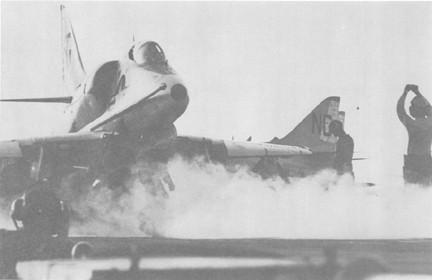
while helos continued to search for the two missing crewmen. One crew member of the HU-16 was finally confirmed to have been killed in action and there was no trace of the other.
During the week of 16 to 22 March, ENTERPRISE, RANGER, and TICONDEROGA operated at Yankee Station. Generally the bad weather over target areas continued. Aircraft made successful attacks, however, by taking advantage of breaks in clouds and short periods of improved weather. Bomb damage assessment was hampered by bad weather and heavy foliage, but a number of fires and secondary explosions were seen. On 17 March, an ENTERPRISE A-4C disappeared about 20 miles southeast of Vinh. "Missiles away" was called just prior to loss of the contact with the aircraft. Search of the area by a SAR destroyer and helo near the scene failed to yield a trace of the pilot. On 20 March an ENTERPRISE A-4C was lost in the vicinity of 18-23N/105-46E. The pilot ejected and a good chute was observed to land in a field. The pilot appeared to be unconscious and was immediately surrounded and carried off the field by six armed men. That same day an ENTERPRISE F-4B was hit on an armed reconnaissance flight over the North and, when the plane caught on fire, the crew ejected. The pilot was recovered by the SAR helo from WORDEN (DLG 18), but the RIO is presumed to have been captured by one of the many hostile junks in the area. Also on 20 March a TICONDEROGA A-4C on an in-country napalm run disintegrated and crashed after receiving automatic weapons fire about 30 miles southwest of Saigon. The pilot was killed in action. On 21 March, the lead pilot in a three plane ENTERPRISE A-4E flight noticed a bright orange flash in his rear-view mirror. Simultaneously, contact was lost with the two wingmen in the vicinity of 17-58N/106-40E. SAR units recovered two helmets and other survival equipment. Both pilots are missing and presumed dead. The loss is suspected to have been caused by an SA-2 which was visually sighted at the time of the incident, or possibly by mid-air collision from evasive maneuvers under low overcast and poor visibility conditions. TICONDEROGA conducted in-country operations from Dixie Station through 21 March, being relieved by HANCOCK on the 22nd.
From 23 to 29 March, the carrier task group at Yankee Station consisted of ENTERPRISE and TICONDEROGA. Air operations in North Vietnam were severely limited by bad weather during the entire week. Limited radar bombings, however, provided continued harassment of positions in North Vietnam. On 25 March, an ENTERPRISE A-4C disappeared during a bombing run on a ferry in the vicinity of 17-24N/106-30E. Air and surface SAR were negative, and the pilot was declared missing. HANCOCK conducted in-country support operations from Dixie Station throughout the week. Commencing on 26 March, HANCOCK aircraft provided daily air support to Operation JACKSTAY in the Rung Sat Special Zone, scheduling 20 to 50 sorties daily.
On 31 March, KITTY HAWK relieved HANCOCK on Dixie Station, and HANCOCK proceeded to Yankee to relieve TICONDEROGA on 1 April.
F-4B Shortage
COMNAVAIRPAC, in a message to CINCPACFLT and CNO, stated that the availability of F-4B aircraft was critical and has been so since December. He pointed out that two squadrons scheduled to deploy in April had to be held to 12 planes each. Further, he stated that the two remaining squadrons, scheduled to deploy in August, presently have a total of 11 operational aircraft--eight in one and three in the other--and that all of March's production plus one additional aircraft will be required to bring these squadrons up to 10 aircraft each. He went on to state that if the present Southeast Asia attrition continues, the current PACFLT F-4B inventory is inadequate to maintain deployed squadrons at authorized allowance. In addition, CONUS based squadron operational readiness will be jeopardized.
To provide the needed aircraft for the Pacific Fleet, CINCLANTFLT offered to reduce the number of aircraft in squadrons deployed to the Mediterranean from 12 to a minimum of 10. He considered it essential, however, that LANTFLT be provided with 8 F-4B's from new production in April and 5 in May.
SP-5 Incident
An SP-5 on a routine MARKET TIME patrol on 5 March in the Gulf of Siam was fired upon by a Cambodian PT boat. The pilot believed that he was over South Vietnam waters, but a later check indicated that he had been using a chart on which the Brevie Line (boundary between Cambodia and South Vietnam drawn in 1939 by the Governor General of Indo China) was improperly drawn. His plane was not hit and he did not return the fire. The error appeared to be his.
Cartography
On 1 March there was initiated a reconnaissance project to map Laos from the southern border to 19-30N. It was to be accomplished by VAP-61's RA-3B aircraft operating directly from Cubi Point. The specified scale of the photography was 1:50,000 with nickname COWBOY assigned. By 15 March 12,140 flight line miles of the assigned 13,456 were completed.
Another photographic project similar to this was assigned VAP-61 in North Vietnam covering ROLLING THUNDER package areas I, II, and III. Package areas I and II were completed early, but coverage of area III was held back due to the increased SAM threat and the special vulnerability of aircraft that had to fly multiple, straight and level flights. Project names in North Vietnam were COWBOY II and PINCUSHION.
Marine Air Operations
March was by far the most active month for Marine air operations from the five airfields used by the Corps in the I Corps area of South Vietnam. Marine fighter and attack planes flew 5,637 offensive sorties, setting a new record. Marine helicopter sorties were slightly below the record set in March; but they added up to 33,268 and resulted in the transport of 47,883 passengers. The location of the Marine air fields along the coast of South Vietnam allowed this heavy volume of operations to be easily supported by sea-transported supplies.
Operations in Laos
CINCPAC informed COMUSMACV that conclusions reached during the Honolulu Conference concerning Laos were that forces necessary to generate 3000 sorties a month would be provided from carrier and Thai-based sources. In addition, anything over 3000 sorties a month would be provided at the discretion of COMUSMACV from air assets allocated for in-country operations. Intelligence during February and target development indicated that more than 3000 sorties could be utilized.
Operation JACKSTAY
A major amphibious operation was launched on 26 March in the Rung Sat Special Zone by the Seventh Fleet's Special Landing Force, and other American and South Vietnamese units.
The Rung Sat Special Zone is ideally suited for the capabilities of the Navy-Marine team. It is largely inundated at high tide and its primary lines of communications are rivers and canals. Further, it lies astride the major waterways connecting Saigon, South Vietnam's major port, with the sea.
During February and early March, the danger posed by the almost undisputed Communist control of the Rung Sat Special Zone was underscored by three attacks made on merchant shipping enroute to Saigon. The last of these came on 2 March when the Panamanian transport PALOMA was attacked and set afire in a position only four miles up river from the site where an ambush had been launched three days earlier against another merchant ship.
In the aftermath of this attack, COMUSMACV asked that the Seventh Fleet's Special Landing Force be committed for about 10 days to penetrate the Rung Sat Specia1 Zone and disrupt Viet Cong activities. Planning for the operation began on 10 March 8t the headquarters of the Naval Advisory Group, MACV. D-Day was set for 26 March, with the initial landings to come on the Long Thanh peninsula thirty miles southeast of Saigon. The naval force assigned to the operation was the Seventh Fleet's Ready Amphibious Force (COMPHIBRON ONE) consisting of flagship PRINCETON (LPH 5) with ALAMO (LSD 33) and PICKAWAY (APA 222). Attached for special operations were WEISS (APD 135) with a UDT detachment embarked, MERRICK (AKA 97), ROBINSON (DDG 12) for naval gunfire support, HENRY COUNTY (LST 824), WASHOE COUNTY (LST 1165), and RECLAIMER (ARS 42). Aircraft from HANCOCK provided daily air support for the operation.
During the next twelve days, multiple helicopter and surface landings were made by United States and South Vietnamese forces throughout the 300 square miles area in the Rung Sat Special Zone. River and coastal patrol forces supported these operations throughout the period. By the end of the operation, 63 VC were reported killed against U.S. casualties of 5 KIA, 2 missing, and 24 WIA. JACKSTAY resulted in the destruction of three major base complexes upon which the estimated 1000 Viet Cong in the area had depended. Sixty-six individual weapons were taken as well as large quantities of rice and fresh water. The latter commodities were of special importance since the Rung Sat Special Zone has no fresh water and only limited quantities of food naturally available.
The operation was significant in that it entailed the first joint United States-Vietnam amphibious operation of the war. This occurred on 31 March when the Vietnamese River Assault Groups provided a protective screen and minesweeping escort for United States Marines embarked in landing craft. The twenty-four boat convoy worked its way seven miles down the narrow Vam Sat River to make the deepest penetration of the Rung Sat Special Zone. The operation was highly successful, resulting in the destruction of large Viet Cong training, hospital, and supply complexes. This excellent penetration can be attributed to the concept of coupling Vietnamese naval experience in riverine operations with an integral body of assault troops trained in amphibious warfare.
While the areas where the Marines landed were only temporarily sanitized--not conquered--the fact that the Navy-Marine team demonstrated its ability to move freely in the area will weaken the Viet Cong hold in this area and diminish the threat they have posed to the all-important waterway lifelines to Saigon. Of added significance, forces and equipment for this operation were already available in the area, proving again the effectiveness, applicability, adaptability, and flexibility of the Seventh Fleet's amphibious and Marine units.
Conference on Recent Amphibious Operations
A conference was convened in Okinawa by CG FMFPAC at the direction of CINCPACFLT to review recent amphibious operations in Vietnam. The following broad conclusions were reached:
- The doctrine for amphibious operations, including command relationships, as contained in NWP-22(A) is valid and should be meticulously complied with and properly applied.
- The acquisition of timely, detailed, and accurate intelligence will have a significant bearing in bringing the conflict in SVN to a successful conclusion.
- Means of improving amphibious reaction can be achieved by streamlining current procedures and by developing canned and flexible plans applicable to a given situation on short notice.
- Tactical cover and deception, which has not been effected to any measurable degree in amphibious operations in SVN, should be exploited.
Seventh Fleet Operations
Typical of the entire month's operation was 1 March when 7 ships fired support missions for forces ashore. These vessels, TOPEKA (CLG 8), OKLAHOMA CITY (CLG 5), SPROSTON (DD 577), ORLECK (DD 886). WADDELL (DDG 24), JOSEPH STRAUSS (DDG 16), and LEONARD F. MASON (DD 852), fired approximately 1,000 rounds into VC positions. By the end of the month, a total of 19,547 rounds, ranging from 3"/50 to 8"/55, were fired by Seventh Fleet units.
Highlights of these daily missions included the record of WADDELL (DDG 24) which fired 2,139 rounds of 5"/54 ammunition during the first ten days of the month. On 5 March, this ship steamed 5 miles up the Saigon River to shell enemy positions, destroying 4 structures and damaging another 5.
During the night of 10/11 March, BAUSELL (DD 845) came to the rescue of a Vietnamese unit and its American advisors, who were under heavy attack. Star shells from the destroyer caught the VC in the open. Spotters reported that BAUSELL's fire was "dead on target" and that the "enemy are dispersing."
During the night on 9 March, SPROSTON (DD 577) supported a Vietnamese Marine battalion fighting off three VC battalions. The accuracy and timeliness of SPROSTON's fire rendered the attack ineffective and killed an estimated 30-40 of the enemy. Evidence of heavy casualties was indicated when the VC used every door in the nearby village as makeshift stretchers to carry off their wounded.
On 21 March OKLAHOMA CITY (CLG 5), flagship of the Seventh Fleet, brought her 6"/47 guns to bear in supporting a U.S. Marine search and destroy operation south of Danang. One of her first targets was a system of enemy bunkers. One of these installations was destroyed and two damaged.
Weekly totals and results of all gunfire support operations are as follows:
Number of rounds |
Structures damaged |
Structures destroyed |
|
| 1-8 Mar | 3537 |
170 |
113 |
| 9-15 Mar | 4659 |
175 |
146 |
| 16-22 Mar | 3717 |
202 |
183 |
| 23-30 Mar | 5566 |
139 |
153 |
Possible Reactivation of Battleship
In reply to a JCS request for his views on the activation of a battleship for use against targets in North and South Vietnam, CINCPAC noted that in both the North and the South the LOCs are located in an axis along the coast. This, he said, would be an advantage to a battleship being used in NGFS. Also, he pointed out that while cost of activation, availability of personnel, and problems were factors to be considered, they were not insurmountable. If a battleship were to be activated he recommended minimum modifications and alterations in order for the ship to be ready for operations at the earliest possible time.
Other considerations, however, had to be studied. To keep one BB on station, three might have to be activated. Certain targets would have to be studied to determine whether there were sufficient "hard" ones to call for the use of a BB vice other "in-hand capabilities" able to do the same job. If a battleship were used deep in the Tonkin Gulf against North Vietnam targets--which seemed probable--there would be the need for 24-hour air protection. And, further, for its own self-defense, more than just 16" batteries would have to be activated.
The cost of minimum reactivation of one battleship to be brought out of mothballs as a gun platform was estimated to be $11 million during a 10½ to 11½ month period, working a single shift, or $13 million in 7½ to 8 months with three shifts working on the job. However, full reactivation with up-to-date alterations, readying of all internal systems and the effective employment of a full complement would raise the estimated cost to between $17.5 and $20.5 million and would require from 10 to 16 months. Annual operating cost would be approximately $12.8 million, which would represent the cost of consumables but not the cost of ammunition.
In late March the conclusion was reached that the activation of a BB did not appear to be justified.
Casualties to 5"/38 Barrels
FRED T. BERRY (DD 858), PORTERFIELD (DD 682), and HIGBEE (DD 806) experienced a total of eight 5"/38 gun barrel failures during the month. In each case, the barrels began to bulge, usually about 10 feet from the muzzles. An investigation into the cases of these failures was ordered.
Coastal Patrol (MARKET TIME) Operations
General
MARKET TIME forces, commanded by CTF 115 with headquarters in Saigon, continued to maintain barriers at the 17th parallel and on the Cambodian border to halt communist infiltration. In addition, patrols were maintained along the entire coast. Larger ships (DERs, MSCs and MSOs) typically operated 5-20 miles at sea. Smaller craft (PCFs and Coast Guard WPBs, as well as South Vietnamese junks) operated close inshore. Often these shallow water patrols were vectored to suspicious targets by the larger ships. In addition, patrol aircraft stationed in-country or in the Philippines flew daily tracks over the coastal zone. Two AKLs provided logistic support for MARKET TIME forces.
As of 31 March, the following units assigned to CTF 115 were in-country:
- DER - 5
- MSO - 5
- MSC - 3
- WPB - 26 (Coast Guard manned)
- PCF - 25
- ARL - 1
- YR - 1
- AKL - 2
During March, an average of 34 U. S. ships were on daily MARKET TIME patrol. In addition, 9 Vietnamese Sea Force ships and 189 junks were underway daily. Coordination between the United States and Vietnamese forces was exercised by jointly manned Coastal Surveillance Centers at Danang, Qui Nhon, Nha Trang, Vung Tau and An Thoi. In addition, U. S. naval advisors were assigned to Vietnamese junk divisions and sea force ships.
Since March 1965, MARKET TIME forces have operated under rules of engagement allowing any vessel (less warships) to be stopped, visited, and searched within the three-mile limit. Within the contiguous zone stretching three to twelve miles from the coast, U.S., ships can demand identification and a declaration of intent from ships of any nation, except for warships. In international waters outside the 12-mile limit, U.S., forces may stop, visit, and search any vessel of South Vietnam.
Anti-infiltration Patrols
Two intensive anti-infiltration patrols were conducted during the month, both of which included a control ship (DER), and smaller U.S. patrol craft, Vietnamese junks were also assigned.
The first of these patrols, BROWN BEAR II, was in the III Corps area (in a sector southwest of Ham Thang village) between 13 and 18 March. One suspect steel-hull ship was apprehended by a WPB, but it was subsequently cleared and released. The use of a DER to act as a mother ship for the two WPBs assigned to the operation again proved to be a success.
Between 19 and 24 March, operation SOUTH WIND was conducted near the Ca Mau Peninsula by a DER, three 81-foot WPBs, and three 50-foot SWIFTs (PCF). In addition to lending logistic support for the patrol craft, the DER carried three relief PCF crews. Although the feasibility of this operation was proved and numerous surface contacts were searched, no VC activity was detected.
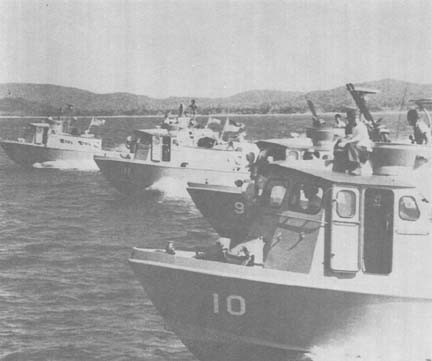
Operation TEE SHOT II
This operation, lasting from 24 to 27 March, was established to interdict possible Viet Cong exfiltration or infiltration in reaction to a USMC/ARVN sweep-and-destroy operation in Quang Ngai Province. Forces consisted of one MSC and one MSO for the outer barrier. Two PCFs and Vietnamese junks were inshore. On 25 March, PCF 20 gave gunfire support. But the operation proceeded without further incident.
Several problem areas were uncovered during this operation, most of which stemmed from the use of an MSO (instead of a DER) as a control ship. The MSO was too small to carry relief personnel for the PCFs, requiring the SWIFTs to leave their stations to change crews. Coordination within the task group and with the Vietnamese junks was seriously hampered by the lack of appropriate communications equipment on the minecraft.
Rung Sat Special Zone Operations
To interdict supply operations of the Communist forces in the Rung Sat Special Zone, a joint PCF-WPB patrol was established on 7 March in the Soi Rap River. On the first night of the patrol, USCGC POINT WHITE made radar contact on a suspicious junk. In the ensuing engagement, the WPB rammed and swamped the junk, leaving it in a sinking condition. Four Viet Cong were captured, together with equipment and documents. On 15 March POINT PARTRIDGE engaged and damaged another junk, but shallow water allowed the contact to escape.
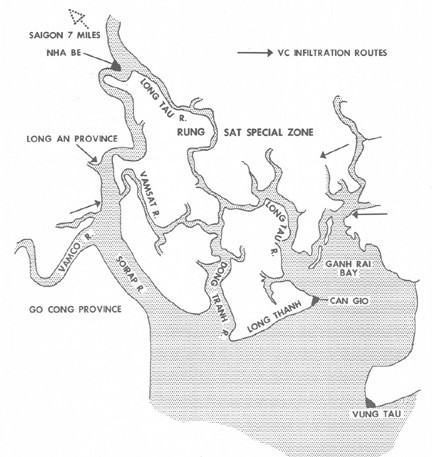
22 March USCGC POINT HUDSON drew fire from another junk on the river. In the battle that followed, an estimated ten Viet Cong were killed.
During Operation JACKSTAY, commencing on 26 March, river patrol forces on the Soi Rap and other Rung Sat Rivers were expanded. Several sharp surface engagements resulted.
On the Soi Rap River, PCF 31 traded fire on 26 March with a junk which managed to escape into shallow water. On the following day, PCF 31 returned the fire of another junk and cut the craft in two. Five VC were killed.
On the Dong Tranh River, also in the Rung Sat Special Zone, PCF 26 ran into an intense ambush by .50 and .30 caliber machine gun fire during 26 March. She suppressed the attack with machine gun and mortar fire, but suffered two personnel wounded and light material damage.
MARKET TIME Air Operations
SP-2H aircraft from Tan Son Nhut airfield near Saigon, SP-3As from Sangley Point in the Philippines, and SP-5Ms from a seadrome maintained by SALISBURY SOUND (AV 13) at Cam Ranh Bay, provided continuous aerial surveillance of the coastal zones of South Vietnam during the month. Seven hundred thirty-three flying hours were logged.
Additional air surveillance was provided by Army Mohawk aircraft equipped with side-looking airborne radar. The data from these flights were evaluated and relayed to MARKET TIME units by the Coastal Surveillance Centers.
River Patrol (GAME WARDEN) Operations
Patrol Force
Eleven PBRs, the first of the River Patrol Force (CTF 116), arrived on 21 March, followed by an additional nine units on 30 March. These fiberglass boats are 31 feet long, displace only 2.5 feet, and have a maximum speed of 25 knots. They are armed with a twin .50 caliber and a single .30 caliber machine gun. A total of 120 PBRs have been ordered for delivery to South Vietnam.
The River Patrol Force is intended for operation in the Mekong Delta, the Delta estuaries, and the Rung Sat Special Zone. Administrative control is exercised by River Squadron 5, homeported in San Diego, which was established on 15 March. Operational control derives from Commander Naval Forces Vietnam.
During March, training and area indoctrination for PBR crews were conducted in the area of Vung Tau. Numerous boat alterations were under consideration and experimentation. The first of eight permanent GAME WARDEN bases, located at Cat Lo, was partially completed. With the exception of the site at Vinh Long, land had been acquired for the other bases.
From 21 to 24 March, a GAME WARDEN conference was held at CINCPAC headquarters at which a number of important decisions were taken. One of these was to assign to the Service Force, Pacific Fleet, responsibilities for all maintenance except for emergency repairs. Necessary steps were also taken to establish personnel allowances for GAME WARDEN. Of 84 officer and 1159 enlisted billets, 69 officers and 688 enlisted were assigned to River Squadron 5. The balance will man the support bases.
River Minesweeping
From January 1964 through 2 April 1966, 77 river mining incidents were reported in South Vietnam, resulting in 20 Vietnamese boats destroyed, 57 damaged, 115 men killed, 138 wounded, and 43 missing in action. In almost all cases, the Communist mines were controlled from shore.
Because of the dimension of the mine threat and the limited countermeasures available to the South Vietnamese Navy, CINCPACFLT directed the redeployment of 4 55-foot minesweeping boats (MSB) from harbor defense duties in Danang to the Long Tau River south of Saigon. These boats arrived at Vung Tau on 10 March and proceeded to Nha Be for training purposes. Starting on 26 March, the MSBs made two daily sweeps of the Long Tao River which provides the basic line of communications between Saigon and the sea. They are supplementing the sweeping activities of the Vietnamese Navy, in the process providing more complete coverage of the ship channel. The wooden craft operated from temporary facilities at Nha Be.
Since the creation of the Vietnamese Navy in 1953, U.S. naval advisors assigned to the Naval Advisory Group have sought to improve the material readiness of this new fleet, promote sound doctrine, and motivate Vietnamese officers to become more aggressive in their operations against the enemy. By March 1966, the Vietnamese Navy was manned by more than 23,000 officers and men, about 7,000 of whom were Marines. Their fleet included 21 seagoing ships (PC, PCE, PGM), 15 mine warfare types (MSC and MSB), 138 amphibious ships and craft (ranging from LST to LCVP), 488 junks, and about 75 other ships and craft. Almost 1,000 U.S. Navy men were attached to the Naval Advisory Group, many of whom were assigned to operating units of the Vietnamese Navy.
An example of the Vietnamese Navy's increasing aggressiveness was the record of their seven River Assault Groups during the month. In this period, fifteen small-scale sweep operations, some of which were highly successful, were launched against the Viet Cong by the small craft assigned to these groups and by embarked troops. U.S. naval advisors, who have long worked closely with the RAG's, report that there are several advantages to these small operations. They can be planned and executed quickly, thereby preventing security leaks. The RAG's also have the ability to lift troops to the scene with speed and secrecy. A major problem area, however, is the uncertainty that troops will be assigned for these operations. The Vietnamese Navy and their U.S. naval counterparts have long sought to have an integral troop force assigned to the River Assault Groups. But, to date, Vietnamese authorities have not given this capability.
Another problem is the security of the coastal group junk division bases scattered along the entire coastline of South Vietnam. Many of these bases are in areas of Communist control. During March, one underwent a heavy mortar attack, and another was the subject of internal sabotage. In the latter instance the commanding officer of the coastal group was killed. U.S. advisors who are assigned to each coastal group continue to seek improvements in the security situation.
Two critical areas of special concern to the U.S. naval advisors are maintenance and personnel. The maintenance for larger ships of the Vietnamese Navy was considered to be unsatisfactory during the month. The hulls of many junks in the coastal groups are in a bad state of deterioration and engine malfunctions are common. The major difficulty with personnel is their lack of motivation. Many Vietnamese officers and petty officers are considered to be very good; but the majority show little or no desire to become good leaders.
The Navy's Military Sea Transportation Service continued to provide the basic flow of supplies to South Vietnam upon which all friendly fighting forces in the country depended. During March, MSTS cargo manifested for South Vietnam totaled 691,000 measurement tons, which compared to 614,000 tons in February and 524,000 tons in January. Improvement in the unloading situation was reflected to some extent in the average time that MSTS controlled or chartered ships remained in South Vietnamese ports. During March, this was about 15 days, which compared to an average of 31 days in January 1966.
The ports of Danang and Chu Lai, which were managed by the Naval Support Activity Danang, were of special interest to the Navy. Despite strikes and work stoppages in these areas, the Support Activity posted a new record for offloading cargo when slightly more than 200,000 measurement tons were placed ashore.
Although 98% of all cargo to South Vietnam goes by sea, some high-priority cargo is shipped by air. In order to ease the heavy backlog of air cargo, the aircraft and crews of the Naval Air Reserve Training Command have been used to provide additional airlift to Southeast Asia. In March these reservists set a new record when they transported 259,523 pounds.
The ships of the Seventh Fleet continue to be supplied by the Service Force, Pacific Fleet. During March, Service Group 3 made a total of 598 underway replenishments in the WESTPAC area, 119 of which were conducted at night. Some concept of the immensity of these operations can be gained from the record of SERVGROUP 3 AOs, which delivered 1310 MBBLS of bulk POL products in underway replenishments.
The shortage of 5"/54 ammunition continued to create concern. According to CINCPACFLT, continued expenditure at the March rate would deplete the combined assets of WESTPAC and the West Coast within three months. Accordingly, CNO was requested to investigate other possible sources for 5"/54 AAC and HC projectiles for transfer to PACFLT.
At the end of March, the Headquarters Support Activity Saigon (HSAS) was scheduled to transfer many of its supply responsibilities to the Army. These included the operations of the Navy commissary store, billeting, and the Navy hospital. When HSAS was established in July 1962; it was charged with supporting the then small Military Assistance Command, Vietnam. But as U.S. participation in the Vietnamese war increased, so did the demands on the command. By March 1966 the 952 officers and men assigned to HSAS were running the Navy's largest single overseas shore command. An example of one of its many responsibilities was to operate and administer the largest military hotel system in the world. By the end of March, this included 52 villas, 23 BOQ's, 26 BEQ's and seven transient hotels housing some 2,000 officers, 3,900 enlisted, and 1,600 transients.
An important step in assuring the security of the line of communications to Saigon was the opening of an alternate channel. The Long Tau River, which up to this point was the sole ship channel to Saigon, is narrow and passes through an area highly advantageous to an enemy seeking to disrupt shipping. In March, Vietnamese authorities, with the encouragement of U.S. officers took steps to provide buoys and beacons for the Soi Rap River which is wider and passes through areas that are relatively more secure. Better charts of the Soi Rap are also under preparation. At mean high water, the Soi Rap will be able to accommodate vessels with drafts up to 29 feet.
Virtually all of the 2,188 men assigned directly to the Third Marine Amphibious Force are corpsmen and doctors. Their achievements in daily combat in caring for the wounded cannot be praised too highly. In addition, their work among the
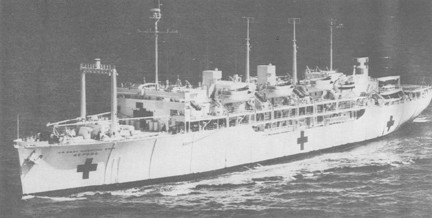
population has been a vital component in achieving the pacification of the areas in which the Marines operate. In March alone, 849035 civilians were given medical and dental treatment. Seventy-seven Vietnamese doctors, nurses, and technicians were trained by their American counterparts.
Because of the higher priorities assigned to other construction projects, the expansion of the Naval Hospital at Danang has come to a virtual stop. As it stands now, the hospital has 172 beds available out of a programmed total of 400 beds.
Due to a casualty in her main feed pump, the hospital ship REPOSE (AH-16) was removed during the month from its support of the Third Marine Amphibious Force. Repairs on this 750-bed floating hospital are expected to be completed on 3 April.
Two salvage operations were conducted during the month by units of Service Group Three.
On 5 March, BOLSTER (ARS 38) and RECLAIMER (ARS 42) succeeded in pulling free the grounded merchant tanker SEA RAVEN in the Chu Lai area. RECLAIMER then towed the ship to Cam Ranh Bay where the tow was transferred to a commercial tug on 8 March.
On 11 March, SUMMIT COUNTY (LST 1146) suffered flooding in her engine room after grounding near Chu Lai. HITCHITI (ATF 103) arrived on 12 March to assist the LST in patching the engine room bottom and preparing the ship for tow. The tug then proceeded to tow the LST to Sasebo for permanent repairs. On 24 March, however, BOSTER took over this task in a position near Taiwan, allowing HITCHITI to visit Hong Kong for a well deserved period of rest and recreation.
In March CINCPACFLT directed that harbor defense facilities be established in the ports of Vung Tau, Cam Ranh Bay, Qui Nhon, and Nha Trang. Mobile Inshore Underseas Warfare Surveillance Unit (MIUWS) 11, which had provided this capability at Danang since May 1965, was accordingly moved to Vung Tau and a second PACFLT MIUWS unit was deployed to Cam Ranh Bay. MIUWS units for the other two ports will come from Atlantic Fleet resources. The required personnel to man the patrol boats and shore installations in these four harbors will amount to 833 officers and men.
Harbor defense in Danang has been assumed by a semipermanent harbor defense installation under the command of the Naval Support Activity Danang. It is planned to eventually replace the MIUWS units in the four additional ports with similar commands.
The primary surveillance effort of the MIUWS units is directed against the threat of covert attack, including possible attack by mortar-equipped or explosive-loaded junks and underwater swimmers.
The Bureau of Yards and Docks authorized CINCPACFLT to expend $157,000,000 for the military construction program in South Vietnam. Also during March CINCPACFLT submitted an emergency military construction program request for South Vietnam that totaled $530,476,0000 These funds were considered necessary to fulfill the Navy's assigned responsibility to administer construction projects required by all services and DOD activities in the Republic of Vietnam.
In addition, the Navy's SEABEEs are undertaking numerous construction projects in direct support of the Third Marine Amphibious Force. At the end of the month, five Mobile Construction Battalions (numbers 1, 4, 5, 8, and 11) were assigned to Danang and Chu Lai under the overall command of the 30th Navy Construction Regiment. Some examples of their achievements include: the construction of two bridges; five 10,000 BBL POL storage tanks; 178,000 square feet of covered storage for NSA and the Third MAF; and major progress on two ammunition storage facilities and a water supply distribution system.
In addition, three SEABEE Technical Assistance Teams (STATS) operated in various parts of South Vietnam during the month. These 13-man teams have received high praise for their versatility and for their excellent work in civil action. STATS 1007, located at Tay Ninh, is an excellent example of these units. During the first ten days at its new station, this team repaired 2.7 miles of road, hauled fill for a new POL storage site, established a program to help a Vietnamese orphanage, and took steps to organize and direct a Boy Scout group composed of the sons of local policemen.
SEVENTH Fleet submarines continued to support the Southeast Asia effort with continuous patrols in the Hainan area. The principal purpose of these patrols was to detect and report any deployment of foreign naval forces, especially submarines, and secondarily, to gather information of intelligence value including:
- Monitoring movements of all shipping.
- Assisting in maintaining current the naval and electronic order of battle of foreign forces.
- Conducting beach reconnaissance surveillance and assisting in fixing the precise locations of radars and missile sites using passive methods.
On 13 March USS GREENFISH on patrol observed, among other shipping, a ship of Albanian registry proceeding from Chan-Chiang toward the Hainan Strait in loaded condition with a deck cargo of approximately 30 military trucks and vehicles.
As of 31 March, more than 54,000 officers and men of the Third Marine Amphibious Force were ashore in the I Corps area at the following locations:
| Danang | 30,783 |
| Chu Lai | 19,416 |
| Hue/Phui Bai | 4,147 |
Total |
54,346 |
The Marines gave major attention to seeking out and destroying major enemy units. To this end, 16 ground operations of battalion size or larger were carried out, accounting for 1,038 enemy killed, 18 captured, and 113 weapons seized.
In addition, the campaign continued to identify and destroy the Viet Cong military and administrative infrastructure and to provide an environment of security for the population. The large unit operations were in part designed to achieve this goal. But this effort depended primarily upon a continuous series of small counter-guerrilla operations. During March, these numbered 11,245 of which 6,884 were small unit search and destroy operations and 4,361 were ambushes. A total of 385 guerrillas were killed in these actions.
Closely related to the counter-guerrilla and pacification campaign was the Marines' comprehensive civil action program. Some idea of the dimension of this effort is reflected in the fact that the Navy's medical personnel assigned to the Third MAF gave medical treatment to the more than 84,000 civilians previously mentioned. Eighty construction projects were undertaken for the South Vietnamese and 44,595 pounds of food were distributed. These efforts were showing evidence of paying dividends in the pacification of the I Corps area, especially as intelligence reports and other types of cooperation from the rural population allowed the Viet Cong to be more readily identified and eradicated.
The Marines reported that the political unrest in Danang and Hue had no direct effect upon their combat operations. Nevertheless, it was feared that if this unrest continued it would have an adverse impact on operations.
The Commander in Chief, Pacific Fleet, points out the following lessons:
- In making an approach to the coast in an SAR situation, it is essential to know the location of enemy coastal batteries. If not known in advance, the approach should be delayed until the enemy reveals himself. During the approach, medium and heavy batteries should be silenced. Then, naval gunfire efforts should concentrate on suppressing small arms fire directed at the survivors.
- Due to an overload at West Coast private shipyards, reactivation of ships will take 30% longer than previous estimates have indicated. The costs will be increased proportionately.
- Operation JACKSTAY pointed up the soundness of Navy and Marine amphibious doctrine. The Marine Corps' emphasis on small unit leadership and tactics was of special importance in allowing an elusive enemy to be ferreted out and destroyed.
The Defense Intelligence Agency noted that on 4 March 2 to 3 MIGs made an unusual attack on a formation of Air Force F-4C's. The attack was unsuccessful but the enemy attacked from below instead of seeking an altitude advantage. This departure from earlier tactics was probably aimed at degrading the capabilities of early-warning aircraft which normally are able to alert our fighters to the presence of hostile aircraft.
HANCOCK commented to CTF 77 during the month on the subject of defense against SAM. Pilots, it was pointed out, should not operate at mid or high altitudes in a known SA-2 environment and should not depend on passive or active ECM for protection. In addition HANCOCK said:
- In proceeding to and from the target, the altitude selected should be no more than 5000 feet in a SAM environment, and it might vary from on the deck in a desolate jungle area to 5000 feet over high density AAA.
- In the immediate target area a pop-up to 5000 to 8000 feet is necessary to effectively deliver the ordnance which, if properly timed, can be done without undue risk from SAM's.
- Maneuvering in response to a FANSONG alert will consist of a rapid descent to 3000 feet or below, unless AAA considerations make this prohibitive.
- Flights should never repeat never be flown in or above an overcast in a SAM environment.
Lengthy comments were also made on lessons learned by Commander Destroyer Squadron 24, who recently completed a deployment to Southeast Asia:
- The Seventh Fleet is in a wartime environment. Schedules are and must be considered flexible. Commanding officers should ascertain so far as possible the intent of tactical and administrative superiors and try to conform to such intentions. Accordingly destroyers are required to "play it loose" and be flexible to required and quick changes in the operational environment.
- Propulsion plant reliability is an absolute must. While under some circumstances certain equipment CASREPs can be tolerated, it is absolutely imperative that preventative maintenance be kept up and routine repairs made as soon as operations permit.
- The communications load in Seventh Fleet destroyers is several orders of magnitude greater than in the Second or Sixth Fleets. Messages must not be missed. Accordingly, it is imperative that communications officers personally screen all incoming traffic.
- While not strictly "according to Hoyle," it is a near requirement that commanding officers and unit commanders themselves read all traffic so as to gain insight into the general situation in the South China Sea and hence be in a position to best respond to requirements and situations as they may come up.
- The Army and Marines are relearning the value of naval gunfire support. The advantages of the ability of a surface "gun ship" to continually position herself on station, and deliver gunfire repeatedly with near or actual artillery precision on targets within range of her guns, and the ability to move at high speeds up and down the coast, have again become apparent after a lapse of nearly 15 years. In addition, the delivery of harassing and illumination fire is again recognized as a significant deterrent to infiltration by enemy troops.
- Somehow it is necessary that commanding officers of destroyers inculcate the officers of the deck with the necessity for using all sensors in station keeping. In particular, it appears that the use of binoculars to estimate distances, particularly at night at ranges under 1500 yards, is becoming a lost art. Too often OOD's are so engrossed in a PPI picture and a CIC solution to take station that they "lose the bubble" and do not recognize a developing dangerous situation. There is no substitute for binoculars, Mark I Eye Ball, good common sense, and taking proper action in avoiding dangerous situations.
